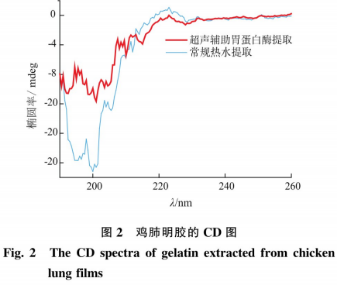2017年,高效构性中国的酶提鸡肉产量为1200万吨,鸡肺产量约为8.5万吨,取鸡其结但其高值化产品的肺明开发与综合利用却没有很好地进行。鸡肺难以清洗,胶及故不为人类食用。研究目前,高效构性鸡肺基本以赠送的酶提方式外包给养殖户作为狐狸和貂等的动物饲料或直接弃置于环境中,造成副产物资源浪费以及环境污染。取鸡其结鸡肺干物质中蛋白质质量分数高达70%,肺明但现有文献对鸡肺的胶及研究极少。李小勇、研究王春焕等对猪肺及牛肺中的高效构性胶原蛋白进行了提取和纯化,为从动物肺中提取蛋白质提供了可行性参考,酶提但有关鸡肺胶原蛋白的取鸡其结理化性质研究并未见报道。明胶是一种从猪、牛、鱼等动物性食品副产物中提取的天然高分子化合物,是胶原在酸、碱、酶或高温下的水解变性产物,可广泛应用于食品工业中。
胶原明胶化的过程涉及胶原三螺旋结构的共价交联的维系和稳定及非共价键的破坏,三螺旋结构从而展开,非螺旋结晶区的破坏使得胶原亚基分子游离出来。制备明胶预处理的方法主要包括酸法、碱法、酶法、超高压法等,目前,广泛应用于生产的只有传统的酸碱法,而对于酶法制胶的理论研究较少。伴随着常规酸碱法产率低、生产周期长及废液污染等问题,Singh等比较了酸和胃蛋白酶预处理的明胶得率和特性,发现酶法提取率高,且对胶原的三螺旋结构无明显影响。超声波产生的空化效应、机械效应等多重效应不但能加快化学反应的进行,促进蛋白质溶出,还能打开胶原的纤维结构促进酶解。Kim等发现超声辅助乙酸提取鲈鱼皮胶原的得率较高。Li等发现超声辅助胃蛋白酶提取的胶原与单一酶法比较,得率较高且生产周期缩短。
作者采用超声辅助酶解法从鸡肺中提取明胶,研究超声辅助酶提明胶的效果及在食品体系中的应用,为肉鸡副产物的高值化利用与综合开发提供理论依据。
1 材料与方法
1.1 材料与仪器
鸡肺:常州市立华牧业有限公司提供:胃蛋白酶(USP级):上海源叶生物科技有限公司提供。
超声波细胞粉碎机(SCIENTZ-IID):宁波新芝生物科技股份有限公司产品;磁力加热搅拌器(78-1):常州国华电器有限公司产品;循环水式多用真空泵(SHB-Ⅲ):南京科尔仪器设备有限公司产品;CHRIST冷冻干燥机(Alpha1-2LDplu):北京五洲东方科技发展有限公司产品;差示扫描量热仪(STA-449C):德国NETZSCH公司产品;圆二色谱仪(Jasco-715):日本Jasco公司产品;扫描电子显微镜(EV0-LSl0):德国ZEISSE0berkochen公司产品;紫外分光光度仪(UV-6100):上海美普达仪器有限公司产品;马尔文激光粒度分析(ZetasizerNanoZs90):英国Malvern仪器有限公司产品;分散均质机T25:德国IKA公司产品。
1.2 试验方法
1.2.1 鸡肺除杂
鸡肺杂蛋白质去除参照李越的方法,并加以修改。
1.2.2 常规热水提取鸡肺明胶
参考张思琦的方法提取明胶,并作改进。
1.2.3 超声辅助酶解提取鸡肺明胶
取10g脱杂鸡肺,溶于0.5mol/L乙酸,200W超声处理10min,超声处理器工作2s,停歇3s。随后于42℃恒温水浴锅中150r/min磁力搅拌,加胃蛋白酶1mL,酶提4h,反应结束后100℃灭酶10min。放置室温,再将样品通过真空抽滤瓶抽滤,收集滤液,倒入干净的表面皿,于-40℃冰箱冷冻,最后冷冻干燥24h,收集样品。
1.2.4明胶得率的计算
明胶的得率根据Nagarajan等报道的方法测定,以去杂原料与制得样品经冷冻干燥后的质量的比值计。
1.2.5热稳定性
明胶的玻璃转化温度用差示扫描量热(DSC)仪测定,参考汲聪玲的方法。精准称量8mg样品蛋白于铝坩埚中,加盖密封,设置温度的扫描范同为20~200℃,升温速率为2℃/min。以空铝坩埚为参比。
1.2.6圆二色谱(CD)
明胶溶液的近紫外圆二光谱变化通过网二色谱仪测定。将制备的样品配制成质量浓度为0.1mg/mL蛋白溶液,注入1mm厚的样品池。设置扫描范同为190~260nm,扫描速度为50nm/min.光谱间隔为1.0nm。CD数据以平均椭圆率表示、采用CDPro软件分析明胶的二级结构。
1.2.7聚丙烯酰胺凝胶电泳(SDS-PAGE)分析
配制分离胶(12g/dL)和浓缩胶(5g/dL),明胶的亚基组分测定参照汲聪玲的方法并作改进。将明胶溶液与DH8.8的0.06mol/LTris-HCl缓冲液、质量分数25%甘油、2%SDS、0.1%溴酚蓝、5%β-巯基乙醇混合,沸水煮10min后10000g离心3min,取10μL上清液上样。用相对分子质量为11000~135000的蛋白Markers做对照。加入电泳缓冲液(质量分数0.1%SDS、0.192m01/L甘氨酸、0.025mol/LTris-HCl),在16mA电流下进行30min电泳后,调节电流强度为32mA继续进行1.5h。电泳结束后,取用R-250考马斯亮蓝对其染色30min,然后用混合液(体积分数20%乙醇与80%蒸馏水)脱色至能辨清条带为止。
2 结果与分析
2.1 明胶得率和效率
明胶的得率为干燥后明胶干质量(g)与脱杂鸡肺干质量(g)的比例。本试验中,胃蛋白提取的鸡肺明胶得率为30.08%,比常规热水提取的鸡肺明胶得率(8.77%)提高了2.43倍。通常,鱼皮明胶的得率为50%左右,鸡肺中的杂蛋白较多,并且鸡肺的韧性及分子内与分子问的交联程度较高,导致鸡肺明胶的提取率较低,仅高于经常规热水提取法制得的军曹鱼(13.8%)、舌鳎(10.3%)、罗非鱼鱼鳞(7.08%)等少数鱼源明胶。
2.2 热稳定性
热稳定性明胶的热变性温度通过差示量热扫描(DSC)法进行测定。加热过程的DSC曲线中的吸热峰所对应的转变斜线中点即为明胶的热变性温度,它表示明胶分子的结构由螺旋向卷曲转变悯。图1显示,明胶胃蛋白酶提取的热变性温度为90.22℃,略低于常规热水提取,这一结果与陈日春的研究相符,通常酸法提取的胶原蛋白变性温度稍高于酶法提取的胶原蛋白。明胶分子的交联作用越多,其变性温度越高,表明胃蛋白酶提取的明胶分子间的交联程度较高。试验提取的鸡肺明胶的热变性温度高于一般的鱼类明胶,如黄华双提取的鱼鳞明胶(27℃)以及刘全娇提取的罗非鱼皮明胶(76.36℃)。因此鸡肺明胶具有热变性温度高的优势,可通过复合改性制备可食性膜用于食品的天然包装中,因为其既不会因为温度的升高在保存期内熔化,又方便产品的运输。此外也可作为稳定剂和增稠剂添加至对温度敏感的冷品,如冰淇淋、酸奶等食品中,能更好地抑制结晶,降低熔化速度,使产品组织更坚实细腻。

声明:本文所用图片、文字来源《食品与生物科技》,版权归原作者所有。如涉及作品内容、版权等问题,请与本网联系
相关链接:胃蛋白酶,明胶,β-巯基乙醇,乙酸